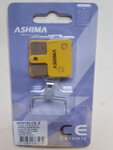I can believe braking that hard would pull you off the seat. A quick 'back of the envelope' calc estimates that braking from 35mph to 0mph in 15 feet will generate 2.7Gs of deceleration. I don't know what the total weight is but assuming something like 300lbs for ebike+rider+cargo then each tire would be resisting 405lb, if they are loaded equally in braking. I'm not sure I could hold on at 2.7Gs, much less avoid skidding the tires, but I suppose it's possible.
This got me thinking, could I actually stop my ebike within 15 feet doing 35mph? It doesn't fit my experience well so I dug a little deeper. I found an online paper that has brake test results that seem useful here. The tests report a max braking force of 450N for a 160mm rotor. For two wheels this yields 900N of braking force. This test used hydraulic brakes, but if you pull the brake lever hard enough you might get to these figures with mechanical disc brakes.
Doing some 'back of the envelope' calcs and borrowing Newton's 2nd law F=ma (where 'm' is total weight & 'a' is the deceleration required to stop in 15 feet = 2.7Gs) we get F=2.7G*9.81m/s^2/G*136kg = 3,602N required braking force to stop within 15 feet from 35mph. Way over the available 900N that the lab tests reported as being available.
A few more calcs show that the available 900N braking force yields a deceleration of 0.67Gs which would stop the bike in ~60 feet. This ignores the tire rolling resistance, but is much more in line with my experience.
So what am I saying? I get up to 35mph+ going down the hill from my home. I'm saying In wouldn't be reasonable for me to plan on stopping within 15 feet, even with hydraulic brakes and 203mm rotors. I'd something more like 60 feet, which is just about the 'alert' distance I've used for some years now. If anything moves into my 'alert' distance, I hit the brakes, hard. Never hit anything yet, but I would have with a shorter 'alert' distance.
